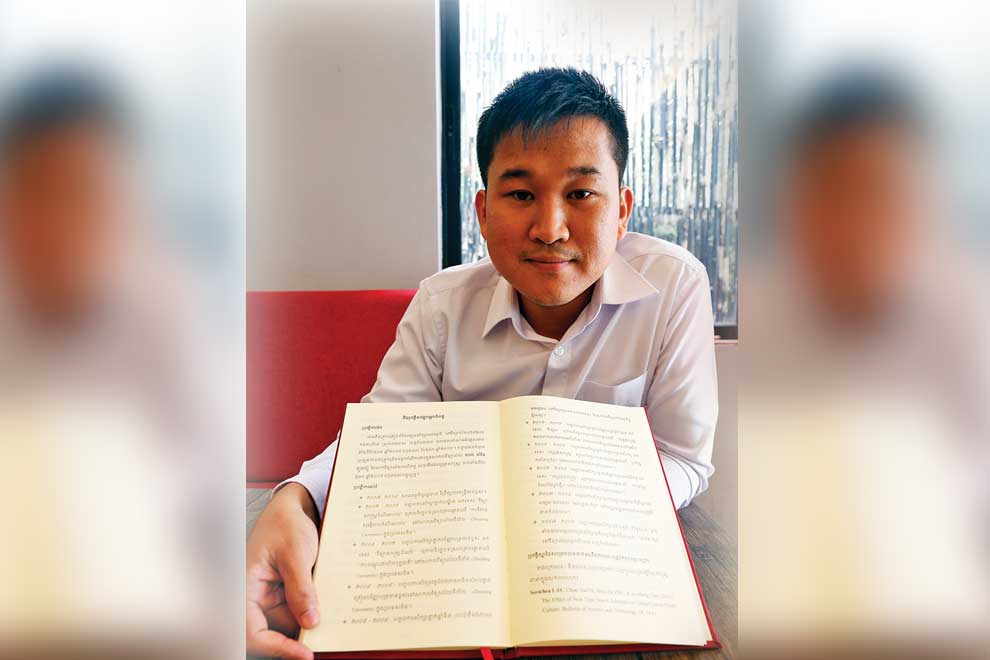
Lay Sovichea with his newly published book Khmer Pinyin, in which he presents a new system for writing Khmer in the Latin alphabet.
Lay Sovichea has taken on a task that at first glance seems mundane, if not tedious. He is trying to standardise a system for writing Khmer with the Roman alphabet, giving some order to what is now a haphazard method.
“If you ask two people to write the names of all 24 provinces of Cambodia or 10 Cambodian people’s names with Roman alphabet, at least there will be a few differences in what they will write down,” says Sovichea, who recently published the book Khmer Pinyin, a guide six years in the making.
While having undertaken a seemingly monotonous process, the 33-year-old food scientist and local university professor is resurrecting an issue that strikes at the heart of Khmer nationalism and historic fears about foreign influence in the Kingdom.
In 1943, the newly arrived French resident George Gautier announced his intention to romanise Cambodia’s 74-letter writing system based on a standard developed by the philologist George Coedes. Gautier attacked the old system as “a badly tailored suit”, and sought to reform written Khmer as part of an overall modernisation of the Kingdom, nearly a century after the French had successfully reformed written Vietnamese.
But the endeavour met intense opposition – especially from Buddhist monks, who saw it as a threat to their culture and identity. Still, the French administration kept pushing the reforms in schools and through its printed publications over the next two years. It was only stopped when the French were pushed aside by the Japanese in March 1945.
In his biography, Sweet and Bitter Memories, Prince Norodom Sihanouk claims that it was he who put an end to the effort – as it was “strongly opposed by . . . those who uphold tradition”.
“I urgently blocked this reform one day after the attack on the French by the Japanese,” he wrote.
Despite this historical lesson, not to mention his lack of background in linguistics, Sovichea promised himself he would invent a new standard for writing Khmer with a Roman alphabet. Such a system, he claims, would help to avoid confusion and misunderstanding, as well as spelling mistakes in government documents, and would promote cross-cultural exchange.
Much of his inspiration comes from pinyin, the official Romanised system of standard Chinese, which he learned when attending a postgraduate program at Zhejiang University.
“Although Chinese language also has nothing in common with Khmer, it is a very good example of how a nation Romanises its language while retaining the original writing system,” Sovichea says.
For almost every day over the past six years, he has been working on a system which he described as “having the quality to produce all speech sounds in Khmer language”, and also compiled the most frequently used Khmer words from sources such as books and newspapers, written out with his unique system.
While Khmer Pinyin is intended to simplify the Cambodian alphabet, which is the world’s largest, it still incorporates 112 distinct sounds. It uses one symbol, the asterisk, along with Roman letters.
The book provides a table of all the phones – or sounds – as well as examples of their use in sentences, most of which are quotes from political leaders. One is “K*mean* t*ei t*y*banh* cho*b n*eiykaseksa,” a quote from Prime Minister Hun Sen translated as “there is no end to learning”.
“It may look weird and complicated,” Sovichea said. “But once you learn it, you will be surprised at how accurately it produces Khmer speech sounds.”
Like those before him, Sovichea’s work does face criticism.
Seung Phos, a retired professor of Khmer language and a former monk, was sceptical about the system, and concerned that it could threaten the Khmer alphabet.
“I noticed that more and more people on Facebook are writing in Khmer with a Latin alphabet,” he said. “This new system could push people to do it more, which could lead to loss of our original alphabet, which is our identity.”
Meanwhile, historian Michel Tranet speculated Khmer Pinyin will be a “useless effort” due to Cambodian nationalism and because he doesn’t see it as necessary.
“Romanisation was successful in Vietnam because at that time Vietnam was trying to get rid of the Chinese influences, which include Chinese systems of writing,” he says. “The French could not Romanise Khmer because of strong nationalism, and it still exists today.”
Sovichea, though, sees his system as a “complement”, not replacement, of the Khmer alphabet, which could only increase the language’s potential to spread.
“Khmer Pinyin will be an important force in pushing the development of our language and a great response to rapid globalisation,” Sovichea says. “To be honest, my real passion is agriculture, not language – but I just know I have to do it because the country needs it.”
Khmer Pinyin is currently in limited release and only available through the author, who can be reached at his Facebook page or by phone at 077 567 800.







